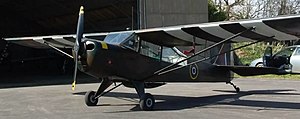No. 695 Squadron RAF was an anti-aircraft co-operation squadron of the Royal Air Force from 1943 to 1949.
No. 691 Squadron RAF was an Anti-aircraft cooperation squadron of the Royal Air Force from 1943 to 1949.
No. 679 Squadron RAF was an anti-aircraft co-operation squadron of the Royal Air Force during the Second World War.

667 Squadron AAC is a former squadron of the British Army's Army Air Corps (AAC).
No. 666 Squadron AAC (V) is a former squadron of the British Army's Army Air Corps (AAC). It was previously No. 666 Squadron RAF, a unit of the Royal Air Force during the Second World War and afterwards became a Royal Auxiliary Air Force (RAuxAF) squadron between 1 May 1949 and 10 March 1957.
No. 650 Squadron RAF was an anti aircraft co-operation squadron of the Royal Air Force during the Second World War.
No. 663 Squadron was an air observation post (AOP) unit, manned with Polish Army personnel, which was officially formed in Italy on 14 August 1944. Numbers 651 to 663 Squadrons were air observation post units working closely with Army units in artillery spotting and liaison. A further three of these squadrons, 664–666, were manned with Canadian personnel. Their duties and squadron numbers were transferred to the Army with the formation of the Army Air Corps on 1 September 1957.
No. 516 Squadron RAF was an army co-operation squadron of the Royal Air Force during the Second World War.
No. 520 Squadron RAF was a meteorological squadron of the Royal Air Force during the Second World War.
No. 521 Squadron of the Royal Air Force was a Second World War meteorological observation unit operating from Norfolk.
No. 540 Squadron RAF was a photoreconnaissance squadron of the Royal Air Force from 1942 to 1956.
No. 510 Squadron was a Royal Air Force transport and liaison aircraft squadron that disbanded during April 1944. It operated during the Second World War having formed during October 1942.
No. 526 Squadron of the Royal Air Force was a British Second World War calibration and communications squadron.
No. 529 Squadron RAF was a radar calibration unit of the Royal Air Force during World War II. The unit had the distinction to be the only RAF unit to fly autogyros and helicopters operationally during World War II.
No. 538 Squadron RAF was one of the ten Turbinlite nightfighter squadrons of the Royal Air Force during the Second World War.
No. 577 Squadron was an anti-aircraft co-operation unit of the Royal Air Force formed during World War II and active from December 1943 till June 1946 in the defence of the Midlands.
No. 567 Squadron was an anti-aircraft co-operation squadron of the Royal Air Force, formed during World War II and active between December 1943 and June 1946 in the defence of south-east England.

No. 662 Squadron AAC is a squadron of the British Army's Army Air Corps (AAC) which flies the Boeing AH-64E Apache from Wattisham Flying Station as part of 3 Regiment Army Air Corps. It was formerly No. 662 Squadron, a Royal Air Force air observation post squadron associated with the 21st Army Group during the Second World War and later part of the Royal Auxiliary Air Force. Numbers 651 to 663 Squadrons of the RAF were air observation post units working closely with British Army units in artillery spotting and liaison. A further three of these squadrons, 664–666, were manned with Canadian personnel. Their duties and squadron numbers were transferred to the Army with the formation of the Army Air Corps on 1 September 1957.
No. 652 Squadron AAC is a squadron of the British Army's Army Air Corps (AAC). It was previously No. 652 Squadron RAF, a unit of the Royal Air Force during the Second World War and afterwards in Germany.
664 Squadron AAC is a squadron of the British Army's Army Air Corps. It was formerly No. 664 Squadron, a Royal Air Force air observation post squadron associated with the Canadian 1st Army during the Second World War and later part of the Royal Auxiliary Air Force. Numbers 651 to 663 Squadrons of the RAF were air observation post units working closely with British Army units in artillery spotting and liaison. A further three of these squadrons, 664–666, were manned with Canadian personnel. Their duties and squadron numbers were transferred to the Army with the formation of the Army Air Corps on 1 September 1957.




